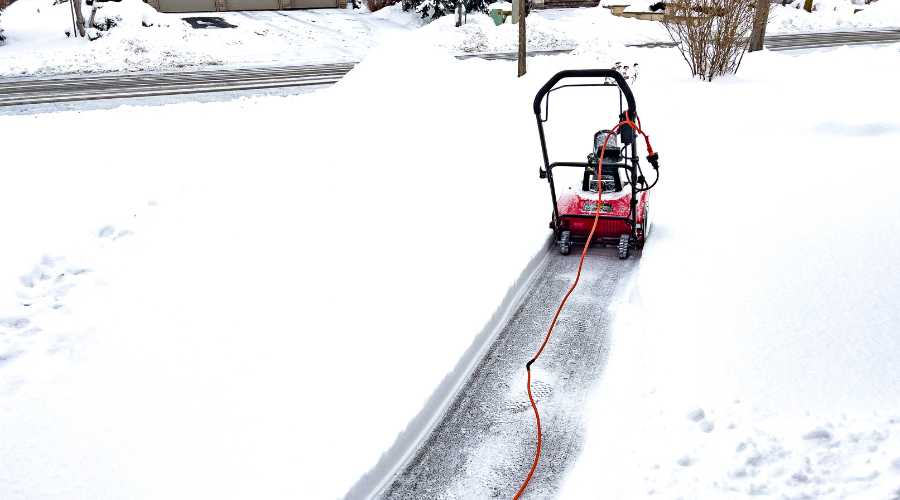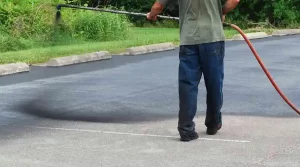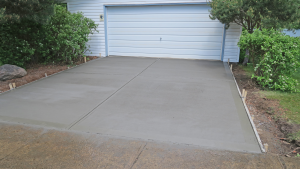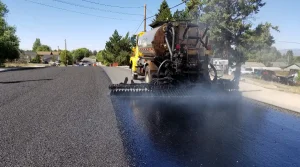As winter sets in, icy driveways become a common hazard. While ensuring safety is paramount, it’s equally important to protect your driveway from the damaging effects of ice melt. This guide will show you how to keep your driveway safe and intact throughout the winter.
Key Takeaway:
- Apply a protective sealant before winter to shield your driveway from corrosive ice melt chemicals.
- Cover freshly laid concrete to prevent early damage.
- Avoid chemical ice melts like calcium or magnesium chloride.
- Choose ice melts labeled “safe for concrete.”
- Repair cracks before winter to prevent water infiltration and freezing damage.
- Apply ice melt before snowfall and clean up residues promptly.
1. Use a Protective Sealant
Before winter arrives, apply a high-quality protective sealant to your concrete driveway. This sealant forms a barrier that prevents ice melt chemicals from seeping into the concrete, reducing the risk of corrosion and extending the lifespan of your driveway. Besides protecting against chemicals, sealants also defend against harsh winter weather, helping your driveway resist wear and tear.
2. Cover Freshly Laid Concrete
Newly poured concrete is particularly vulnerable to ice melt damage. If you’ve recently installed a new driveway, cover it with tarps or insulating materials during winter. This protective layer shields the concrete from harsh weather and chemicals, allowing it to cure properly and gain strength. Taking this step ensures your driveway remains durable and visually appealing for years.
3. Avoid Chemical Ice Melt
Many ice melt products contain harsh chemicals like calcium chloride or magnesium chloride, which can degrade concrete over time. Instead, opt for safer alternatives like sand, cat litter, or plain table salt. These materials provide traction and aid in melting ice without harming your driveway. By choosing eco-friendly options, you not only protect your driveway but also contribute to environmental conservation.
4. Choose the Best Ice Melt for Concrete
When purchasing ice melt, look for products specifically designed to be safe for concrete. Labels such as “safe for concrete” or “concrete-friendly” indicate that the product contains less harmful ingredients. These specialized ice melts effectively manage icy conditions without compromising the integrity of your driveway. Making informed choices ensures you balance safety with long-term driveway maintenance.
5. Fill Cracks and Fissures
Before winter sets in, inspect your driveway for any cracks or fissures. Water can seep into these gaps and freeze, causing the cracks to expand and leading to more significant damage. Use appropriate fillers to seal these cracks and create a smooth surface, reducing the chances of ice buildup. Addressing these issues early strengthens your driveway and minimizes the risk of winter-related damage.
6. Timing of Application and Post-Application Cleanup
The effectiveness of ice melt depends on proper timing and cleanup. Apply ice melt before snowfall or when icy conditions are anticipated to prevent ice from bonding to the surface. After the ice has melted, promptly remove any residual ice melt to prevent prolonged exposure to chemicals. Following a strategic application and cleanup routine enhances the efficiency of ice melt and protects your driveway from potential harm.
Frequently Asked Questions (FAQ)
Q1: What is the best ice melt for concrete driveways?
A: The best ice melt for concrete driveways is one labeled “safe for concrete” or “concrete-friendly.” Products containing potassium chloride or calcium magnesium acetate are less harmful to concrete.
Q2: Can I use table salt to melt ice on my driveway?
A: Yes, plain table salt can be used to melt ice. However, it’s less effective in extremely low temperatures and can still cause minor damage over time if overused.
Q3: How often should I apply a sealant to my driveway?
A: It’s recommended to apply a protective sealant every 2-3 years, or more frequently if your driveway is exposed to harsh winter conditions.
Q4: Why is freshly laid concrete more vulnerable to ice melt?
A: Freshly laid concrete hasn’t fully cured, making it more susceptible to chemical damage and freeze-thaw cycles. Protecting it during its initial curing period is crucial.
Q5: Are there eco-friendly alternatives to chemical ice melts?
A: Yes, eco-friendly alternatives include sand, cat litter, and beet juice mixtures. These options provide traction and aid in melting ice without harming concrete or the environment.
Q6: What should I do if my driveway already has cracks?
A: Seal any existing cracks with a concrete filler before winter to prevent water infiltration and freeze-thaw damage.
Q7: How can I prevent ice from forming in the first place?
A: Pre-treat your driveway with ice melt before snowfall and ensure proper drainage to reduce the likelihood of ice formation.
Conclusion
inter weather poses challenges for driveway maintenance, but with the right strategies, you can ensure both safety and longevity. By applying sealants, using the right ice melt products, and maintaining your driveway, you can prevent damage and enjoy a safe, well-maintained driveway all season long. For professional paving services in Jersey City, reach out to Jersey City Paving—we deliver quality







